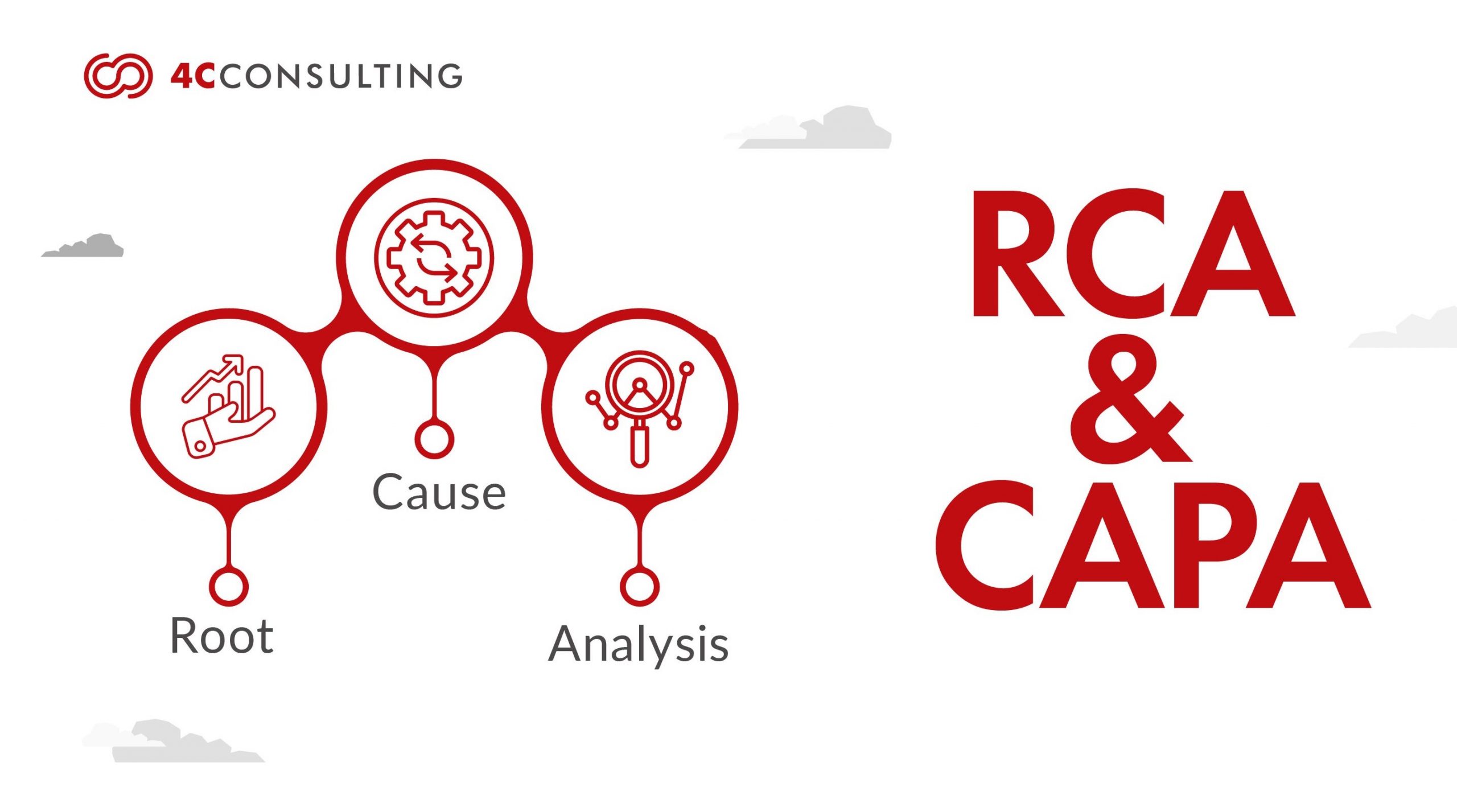
Root Cause Analysis (RCA) and Corrective and Preventive Action (CAPA): Strengthening Organizational Resilience
26th Aug, 2023
In any organization, encountering problems or incidents is inevitable. The key to continuous improvement and maintaining high-quality processes lies in effectively identifying the root causes of issues and implementing appropriate corrective and preventive actions. Root Cause Analysis (RCA) and Corrective and Preventive Action (CAPA) are two essential methodologies that play a pivotal role in identifying the underlying causes of problems and ensuring they do not recur. In this blog, we will delve into the concepts of RCA and CAPA, their significance, and how they synergistically contribute to strengthening organizational resilience.
Understanding Root Cause Analysis (RCA) & Corrective and Preventive actions (CAPA)
Root Cause Analysis (RCA) is a structured problem-solving technique aimed at identifying the fundamental reasons behind an issue, rather than simply addressing its symptoms. The primary objective of RCA is to dig deep into the problem’s origin, seeking to understand why it occurred and what factors contributed to its manifestation. By doing so, organizations can develop effective solutions that target the core issue, leading to lasting improvements.
Corrective and Preventive actions (CAPA), on the other hand, is a process for implementing corrective and preventive actions based on the results of RCA. CAPA involves taking corrective and preventive actions to eliminate the problem or prevent its recurrence, as well as identifying and addressing the underlying causes of the problem.
Together, RCA and CAPA form a critical part of quality management systems, enabling organizations to deliver high-quality products or services that meet customer requirements and expectations.
Importance of Root Cause Analysis (RCA) and Corrective and Preventive Actions (CAPA):
RCA and CAPA helps organizations improve their quality management systems by identifying opportunities for process improvements and identifying trends in quality issues that can be used to make systemic changes. By continuously monitoring and improving quality management processes, organizations can ensure that they are delivering high-quality products or services that meet customer requirements and expectations.
In addition, RCA and CAPA are essential for meeting regulatory and industry standards, such as ISO 9001 (Quality Management System), which require organizations to have processes in place for identifying and correcting quality problems. By implementing effective RCA and CAPA processes, organizations can demonstrate compliance with these standards, improve their reputation for quality, and gain a competitive advantage in the market.
Purpose of Root Cause Analysis (RCA)
The purpose of RCA is to determine the root cause of a problem, so that targeted corrective and preventive actions can be taken to eliminate or mitigate the problem, preventing its recurrence.
RCA involves a structured approach to problem-solving, which includes collecting and analyzing data to identify the underlying causes of the problem. The focus of RCA is on identifying the root cause of the problem, rather than just addressing the immediate symptoms. This allows organizations to implement more effective and sustainable solutions, by addressing the underlying causes of the problem.
The ultimate goal of RCA is to improve the quality and reliability of products or services, by preventing problems from occurring or recurring. RCA is a key element of quality management systems, and is used in many industries and sectors to improved products or services and increased customer satisfaction.
Benefits of Root cause Analysis:
Root Cause Analysis (RCA) provides several key benefits for organizations, including:
- Identifying underlying causes of problems:
- Preventing future occurrences
- Improving quality and reliability
- Enhancing customer satisfaction
- Reducing costs
- Enhancing organizational learning: by analyzing data and information related to problems and issues.
This can lead to improved processes and procedures, as well as increased knowledge and understanding of key business drivers.
Overall, RCA is a powerful tool for identifying and addressing the root cause of problems, preventing their recurrence, and continuously improving quality management processes. By implementing RCA, organizations can improve their products or services, enhance customer satisfaction, reduce costs, and enhance organizational learning.
Steps to perform Root Cause Analysis (RCA):
Conducting an effective Root Cause Analysis (RCA) involves several key steps, including:
- Define the problem.
- Gather and analyze data: This can include observations, interviews, process maps, documents, and other relevant information.
- Identify possible causes: Brainstorm all possible causes of the problem, using tools such as fishbone diagrams or mind mapping. Consider both immediate causes and underlying causes.
- Analyze the data: Evaluate the possible causes to determine which are most likely to be contributing to the problem. Use tools such as Pareto charts or statistical analysis to identify patterns or trends in the data.
- Verify the root cause: by testing it against the available data and evidence. Ensure that the root cause is directly related to the problem and is supported by the available data.
- Develop a corrective action plan: Based on the root cause, develop a plan to address the problem and prevent its recurrence.
- Implement the plan: Based on the above steps built a implementation plan.
- Evaluate and adjust: Continuously evaluate the effectiveness of the RCA process and adjust as necessary to improve its effectiveness and efficiency.
By following these steps, organizations can conduct a thorough and effective RCA, identify and address the root cause of quality problems, and continuously improve their quality management processes.
Corrective and Preventive Actions (CAPA)
Corrective and Preventive Actions (CAPA) is a structured approach to problem-solving that is used to identify, address, and prevent the recurrence of problems or issues. The purpose of CAPA is to identify the underlying causes of problems, take targeted corrective and preventive actions, and monitor the effectiveness of those actions.
CAPA is an essential component of quality management systems. The goal of CAPA is to improve the quality and reliability of products or services, by addressing the underlying causes of problems and preventing their recurrence.
The Corrective Action component of CAPA involves addressing problems that have already occurred, by identifying the root cause of the problem, taking corrective actions to address the problem, and verifying the effectiveness of those actions.
The Preventive Action component of CAPA involves addressing potential problems or issues, by identifying potential causes of problems, taking preventive actions to eliminate or mitigate those causes, and monitoring the effectiveness of those actions.
The ultimate goal of CAPA is to improve the overall quality and reliability of products or services, by preventing problems from occurring or recurring, and continuously improving quality management processes.
Benefits of CAPA
Corrective and Preventive Actions (CAPA) provides several key benefits for organizations, including:
- Identifying and addressing root causes of problems
- Preventing recurrence of problems
- Improving overall quality system
- Enhancing organizational learning: improved processes and procedures, as well as increased knowledge and understanding of key business drivers.
- Meeting regulatory requirements: CAPA is a critical component of many quality management standards and Implementing CAPA helps organizations meet these requirements and maintain compliance with applicable regulations.
Overall, CAPA is a powerful tool for identifying and addressing the root cause of problems, preventing their recurrence, and continuously improving quality management processes. By implementing CAPA, organizations can improve their products or services, enhance customer satisfaction, reduce costs, and enhance organizational learning.
Steps to generate a Corrective and Preventive Action (CAPA):
The following are the typical steps involved in conducting a Corrective and Preventive Actions (CAPA) process:
- Identify the problem: This can be done through various methods such as customer complaints, internal quality control checks, or audits.
- Determine the root cause: This is usually done through a root cause analysis process that involves gathering data and analyzing it to identify the underlying causes of the problem.
- Develop corrective and preventive actions:
- Implement the actions
- Verify the effectiveness
- Document the process: This documentation can be used for future reference and to help improve the overall quality management system.
Overall, the CAPA process is a structured approach to problem-solving that can help organizations identify and address problems, prevent their recurrence, and continuously improve their quality management system.
Implementing RCA and CAPA in Quality Management Systems
Overall RCA and CAPA are powerful tools that can be used to improve quality management in a variety of ways. Here are some examples of how RCA and CAPA can be used to improve quality management:
- Reducing defects
- Improving customer satisfaction
- Reducing costs
- Improving safety
- Improving compliance
Root Cause Analysis (RCA) and Corrective and Preventive Action (CAPA) are invaluable tools for organizations seeking to strengthen their processes, enhance product quality, and mitigate risks effectively. RCA helps identify the root cause of issues, providing the basis for targeted corrective and preventive actions. CAPA, on the other hand, ensures that RCA’s insights are translated into practical solutions, fostering a culture of continuous improvement and organizational resilience. By incorporating these methodologies into their quality management systems, organizations can proactively address challenges, promote sustainable growth, and uphold their commitment to delivering excellence in products and services.
